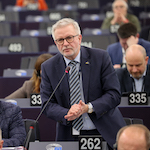
Defending Europe: the time of the Peace Dividend is finally over
It has been just over two years since German Chancellor Olaf Scholz´ ‘Zeitenwende speech, a declaration made in the wake of Russia´s full-scale aggression against Ukraine. What was anticipated to mark the onset of a new era for Germany’s and European defence did so far not live up to the expectations. Franco-German relations are at a low ebb, ammunition production capacities still fall short of what is needed for supplying Ukraine and replenishing our own stocks, and the lack of political will to finally and substantially deepen European defence cooperation reduced the ‘Zeitenwende’ to a political catch phrase .
For the past three decades, Europe has fully enjoyed the ‘peace dividend’, cutting defence spending in order to use it for other “nice to have” purposes. In Germany, for instance, defence spending as a share of total government expenditure more than halved from 3.9 % in 1991 to 1,5 % in 2022. While other sectors flourished in the common European market, the defence industry, which is mostly still a national industry, dwindled.
Accordingly, neither European governments and armed forces nor the industry have been capable to react swiftly to the new reality we have been exposed to at the latest since February 24th 2022.
The EU has reacted with measures to bolster the European Defence Technological and Industrial Base (EDTIB). Key initiatives, such as the European Defence Industry Reinforcement Through Common Procurement Act (EDIRPA) and the Act in Support of Ammunition Production (ASAP) have been devised as short-term instruments to enhance both Ukraine’s´ and Member States’ defence capabilities. EDIRPA aims at consolidating demand of EU Member States by encouraging joint procurement with the EU covering the administrative costs. Meanwhile, ASAP complements EDIRPA by financially supporting the industry to ramp up production capacities. Given the rather limited budget of both instruments with a total of 800 million EUR, the need for long-term mechanisms to ensure a lasting defence readiness persists.
On March 5th 2024, the EU-Commission presented the European Defence Industrial Strategy (EDIS) and the European Defence Industrial Programme (EDIP).
EDIS defines a comprehensive set of measures to improve the Union’s defence readiness through better coordination of joint defence efforts, strengthening of the EDTIB, ensuring security of supply as well as connecting the Ukrainian industry to EDTIB. The EDIP translates the ambitions of EDIS into concrete actions. Its objective is to bridge the gap between ASAP and EDIRPA until the end of the current Multiannual Financial Framework.
The initial Commission proposal, foresees a budget of 1.5 billion EUR for EDIP. Although this amount will already provide for a relevant impact due to its leveraging effect, it is insufficient to compensate for three decades of underinvestment. However, a decisive element within EDIP are the regulatory measures such as the Priority Rated Orders which intend to reallocate existing orders with the EDTIB to give priority to Member States. This mechanism was initially included in ASAP but was rejected by Member States as it was perceived as a “power grab” by the Commission despite the checks and balances that had been included. This reflex neglected the potential of the regulatory elements for fulfilling the EU’s failed promise to deliver 1 million pieces of ammunition by March 2024 to Ukraine, especially considering that the funds for ramping-up production are only starting to be disbursed.
Given that Member States already raised concerns of a “power grab” with regard to EDIS and EDIP in November last year, it seems that the seriousness of the threat is not yet recognised by all. That hampers our ability to take the necessary steps to significantly deepen our cooperation in order to ensure that our armed forces are in possession of the capabilities needed to protect European citizens and interests and deter possible aggressors. By pooling resources, planning and procuring together, we would not only amplify our collective impact and make best use of European taxpayers’ money by achieving economies of scale but also ensure a higher degree of interoperability between European armed forces.
EDIP as a starting point provides tools to that end. However, the decisive factor remains the political will of Member States for taking European defence cooperation to the next level. To effect real change, we need a new mind-set that recognizes the undeniable necessity for collective action in the face of a common threat.
That requires us to move beyond mere national approaches towards defence that are often driven by consideration of national industrial policy interests instead of the overreaching common goal.
For instance, we can no longer afford to undermine the development of the internal market for defence by invoking unjustifiable national exceptions.
Spending more and together is an important step forward but it also needs to be done in a coordinated manner while also making full use of the EU’s existing toolbox and the room to manoeuvre in the treaties.
Therefore, we do not only need a Defence Industry Commissioner but a Defence Union Commissioner (DUC) that coordinates all elements of EU actions such as the European Defence Fund, the internal market for defence and military mobility.
At the same time, the DUC needs to bridge the gap to Member States’ efforts, most notably PESCO and the projects co-financed from the EDF, in order to prioritize and focus our efforts. It is time for the Member States to finally think defence European, especially given the amount of investments needed in an increasingly volatile geopolitical environment. This is particularly relevant facing the risk that we might not be able to count any longer on our most potent strategic partner, the United States. The ‘Zeitenwende’ must arrive in the European capitals. Change only works together.




